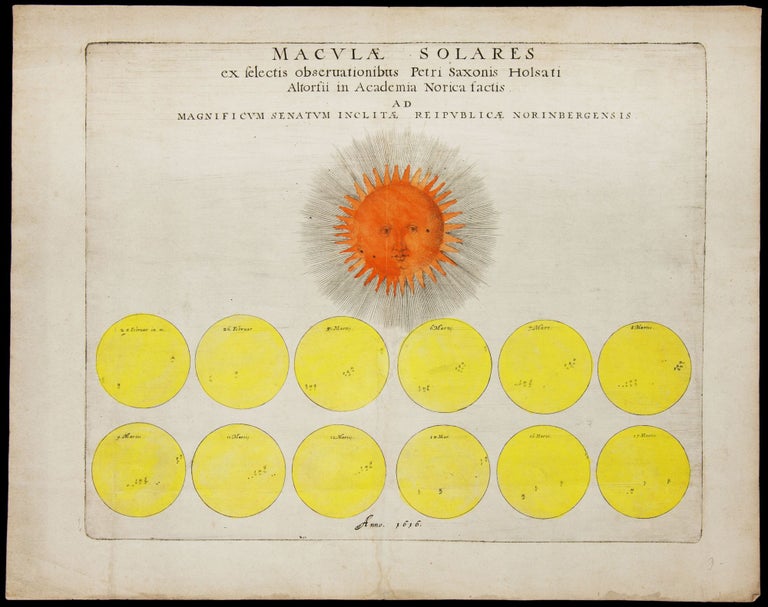
Maculae solares ex selectis observationibus Petri Saxonis Holsati Altdorfii in Academia Norica factis. Ad magnificum senatum inclitae Reipublicae Norinbergensis.
[Nuremberg?], s.n., [c. 1616]. Folio broadside [39.5 x 31.2 cm the sheet; 32.2 x 26.1 the platemark], (1) hand-colored engraving; palate and application of coloring consistent with an early date. Very well preserved, unobtrusive centerfold (as in Nurnberg example), very minor edge toning, unobtrusive damp stain to bottom half of centerfold. Extremely rare first and only edition of this broadside engraving recording the historically early observations of sunspots made in 1616 by the Holstein mathematician Petrus Saxonius (1591-1625). This document is apparently the first separately printed broadside of sunspot observations and just the third ever publication of images of sunspots, following the famous depictions included by Christoph Scheiner (1575-1650) in his Tres Epistolae de Maculis Solaribus (1612) and those included by Galileo Galilei (1564-1642) in his Istoria e dimostrazione intorno alle macchie solari (1613). The engraving – which we find recorded only at the Bayerische Staatsbibliothek and the Germanisches Nationalmuseum Nürnberg – has at its center an anthropomorphic sun, its visage placid in the traditional mode, except that here the sun’s face is afflicted with spots! Below are twelve solar disks showing the appearance and movement of sunspots (individually lettered in the manner devised by Scheiner) as observed in Altdorf by Petrus Saxonicus between 24 February and 17 March 1616 (5 March and 27 March according to Gregorian dating). Saxonius enrolled at the University of Leipzig in 1607 before moving to Altdorf in 1612 to study with the mathematician Johannes Praetorius (1537-1616). In 1614 he began a scholarly tour of the southern German lands, meeting Michael Mästlin (1550-1631) in Tübingen and Johann Faulhaber (1580-1635) in Ulm. Simon Marius (1573-1624), in his Mundus Iovialis (1614, second issue, “Ad candidum lectorem,” ff. G4r-H1r), relates that the “Doctissimus Vir Dominus Petrus Saxo Holsatus, Matheseos Studiosus” visited him in on 4/14 July 1615, having come directly from calling on Christoph Scheiner (1575-1650) in Ingolstadt. Marius writes that he showed Saxonius a drawing of sunspots he had made in 1611, and that Saxonius responded that Scheiner had just shown him similar images (see Neuhäuser & Neuhäuser, p. 806-07). Having returned to the Academia Norica in Altdorf, Saxonius in 1616 made his own sunspot observations. It is not known what occasioned him to have these observations printed in the form of the present engraved broadside. Saxonius inherited Praetorius’ library at his master’s death in 1616, and the collection when joined with his own printed books, manuscripts, and scientific instruments formed an impressive library of modern Copernican astronomy. A manuscript catalog of this library exists (Österreichischen Nationalbibliothek, Cod. 12411), and today the surviving items from this important collection are to be found in Schweinfurt, Erlangen and Munich. OCLC and KVK locate only 2 examples worldwide of this engraving: Bayerische Staatsbibliothek and Germanisches Nationalmuseum Nürnberg. * Lalande, Bibliographie astronomique, p. 164; J. F. Weidler, Historia astronomiae, sive, De ortu et progressu astronomiae (1741), pp. 446-7, 624; R. Wolf, Vierteljahrsschrift der Naturforschenden Gesellschaft in Zürich, Volume 23 p. 176. No. 216; R. Neuhäuser and D. L. Neuhäuser, “Sunspot numbers based on historic records in the 1610s – early telescopic observations by Simon Marius and others,” Astronomische Nachrichten, vol. 337, no. 6 (2011), pp. 789-828; Z. Wardeska, “Die Universität Altdorf als Zentrum der Copernicus-Rezeption um die Wende vom 16. zum 17 Jahrhundert,” Sudhoffs Archiv, vol. 61, no. 2 (1977), pp. 156-164; U. Müller, “Zum Stand der Rekonstruktion der Praetorius-Saxonius-Bibliothek,” Sudhoffs Archiv, vol. 79, no. 1 (1995), pp. 120-23.
Sold
